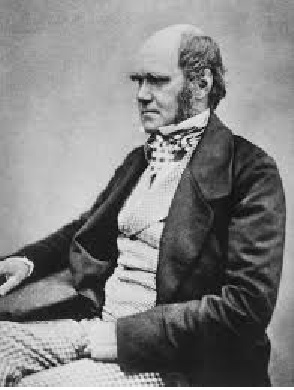
Darwin was born in Shrewsbury, Shropshire. He was the son of Robert Waring Darwin and his wife Susannah; and the grandson of the scientist Erasmus Darwin, and of the potter Josiah Wedgwood. His mother died when he was eight years old, and he was brought up by his sister. He was taught Classics at Shrewsbury Grammar School, then sent to Edinburgh to study medicine, which he hated, and a final attempt at educating him was made by sending him to Christ's College, Cambridge, to study theology (1827). During that period he loved to collect plants, insects, and geological specimens, guided by his cousin William Darwin Fox, an entomologist. His scientific inclinations were encouraged by his botany professor, John Stevens Henslow, who was instrumental, despite heavy paternal opposition, in securing a place for Darwin as a naturalist on the surveying expedition of HMS Beagle to Patagonia (1831-1836).
Under Captain Robert Fitzroy, he visited Tenerife, the Cape Verde Is, Brazil, Montevideo, Tierra del Fuego, Buenos Aires, Valparaiso, Chile, the Galapagos, Tahiti, New Zealand, and Tasmania. In the Keeling Island he devised his theory of coral reefs. During this five-year expedition he obtained intimate knowledge of the fauna, flora, and geology of many lands, which equipped him for his later investigations. By 1846 he had published several works on the geological and zoological discoveries of his voyage — works that placed him at once in the front rank of scientists. He developed a friendship with Sir Charles Lyell, became secretary of the Geological Society (1838-1841), and in 1839 married his cousin Emma Wedgwood (1808-1896).
From 1842 he lived at Down House, Downe, Kent, a country gentleman among his gardens, conservatories, pigeons, and fowls. The practical knowledge he gained there, especially in variation and interbreeding, proved invaluable. Private means enabled him to devote himself to science, in spite of continuous ill-health; it was not realized until after his death that he had suffered from Chagas's disease, which he had contracted from an insect bite while in South America.
At Down House he addressed himself to the great work of his life — the problem of the origin of species. After five years collecting the evidence, he began to speculate on the subject. In 1842 he drew up his observations in some short notes, expanded in 1844 into a sketch of conclusions for his own use. These embodied the principle of natural selection, the germ of the Darwinian Theory, but with typical caution he delayed publication of his hypothesis.
However, in 1858 Alfred Russel Wallace sent him a memoir of the Malay Archipelago, which, to Darwin's surprise, contained in essence the main idea of his own theory of natural selection. Lyell and Joseph Hooker persuaded him to submit a paper of his own, based on his 1844 sketch, which was read simultaneously with Wallace's before the Linnean Society in 1858. Neither Darwin nor Wallace was present at that historic occasion.
Darwin then set to work to condense his vast mass of notes, and put into shape his great work, On the Origin of Species by Means of Natural Selection, published in 1859. This epoch-making work, received throughout Europe with the deepest interest, was violently attacked because it did not agree with the account of the creation of man given in the Book of Genesis. But eventually it succeeded in obtaining recognition from almost all biologists.
Darwin continued to work at a series of supplemental treatises: The Fertilisation of Orchids (1862), The Variation of Plants and Animals under Domestication (1867), and The Descent of Man, which provoked fresh controversy by postulating that the human race derived from a hairy animal belonging to the great anthropoid group, and was related to the progenitors of the orang-utan, chimpanzee, and gorilla. In his 1871 work Selection in Relation to Sex he also developed his important supplementary theory of sexual selection. Later works include The Expression of Emotions in Man and Animals (1872), Insectivorous Plants (1875), The Effects of Cross and Self Fertilisation in the Vegetable Kingdom (1876), Different Forms of Flowers in Plants of the Same Species (1877), and The Formation of Vegetable Mould through the Action of Worms (1881).
Darwin died after a long illness, leaving eight children, several of whom achieved great distinction. Although Charles Darwin was not the sole originator of the evolution hypothesis, nor even the first to apply the conception of descent to plants and animals, he was the first thinker to gain for that theory a wide acceptance among biological experts. By adding to the crude evolutionism of Erasmus Darwin, Lamarck, and others, his own specific idea of natural selection, Darwin supplied a sufficient cause, which raised it from a hypothesis to a verifiable theory.